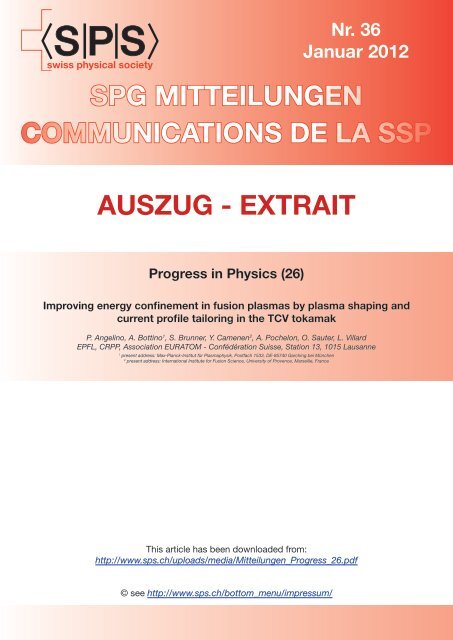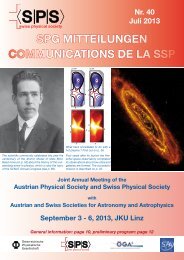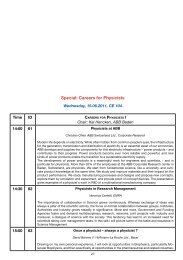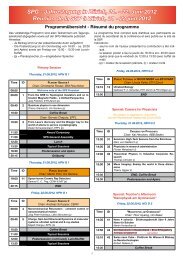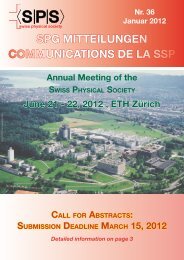Nr. 36 Januar 2012 SPG MITTEILUNGEN COMMUNICATIONS DE ...
Nr. 36 Januar 2012 SPG MITTEILUNGEN COMMUNICATIONS DE ...
Nr. 36 Januar 2012 SPG MITTEILUNGEN COMMUNICATIONS DE ...
You also want an ePaper? Increase the reach of your titles
YUMPU automatically turns print PDFs into web optimized ePapers that Google loves.
<strong>Nr</strong>. <strong>36</strong><br />
<strong>Januar</strong> <strong>2012</strong><br />
<strong>SPG</strong> <strong>MITTEILUNGEN</strong><br />
<strong>COMMUNICATIONS</strong> <strong>DE</strong> LA SSP<br />
AUSZUG - EXTRAIT<br />
Progress in Physics (26)<br />
Improving energy confinement in fusion plasmas by plasma shaping and<br />
current profile tailoring in the TCV tokamak<br />
P. Angelino, A. Bottino 1 , S. Brunner, Y. Camenen 2 , A. Pochelon, O. Sauter, L. Villard<br />
EPFL, CRPP, Association EURATOM - Confédération Suisse, Station 13, 1015 Lausanne<br />
1 present address: Max-Planck-Institut für Plasmaphysik, Postfach 1533, <strong>DE</strong>-85740 Garching bei München<br />
2 present address: International Institute for Fusion Science, University of Provence, Marseille, France<br />
This article has been downloaded from:<br />
http://www.sps.ch/uploads/media/Mitteilungen_Progress_26.pdf<br />
© see http://www.sps.ch/bottom_menu/impressum/
<strong>SPG</strong> Mitteilungen <strong>Nr</strong>. <strong>36</strong><br />
Progress in Physics (26)<br />
Improving energy confinement in fusion plasmas by plasma shaping and<br />
current profile tailoring in the TCV tokamak<br />
P. Angelino, A. Bottino 1 , S. Brunner, Y. Camenen 2 , A. Pochelon, O. Sauter, L. Villard<br />
EPFL, CRPP, Association EURATOM - Confédération Suisse, Station 13, 1015 Lausanne<br />
1 present address: Max-Planck-Institut für Plasmaphysik, Postfach 1533, <strong>DE</strong>-85740 Garching bei München<br />
2 present address: International Institute for Fusion Science, University of Provence, Marseille, France<br />
Introduction<br />
The search for an abundant, sustainable, environmentally<br />
clean and climatically neutral energy source is more important<br />
than ever. Mankind is facing the challenge of a growing<br />
energy demand, particularly under the form of electricity,<br />
with a typical growth of a factor 4-5 expected from now<br />
to the end of the century [1, 2]. The fusion of light atomic<br />
elements like in the stars is an attractive option for several<br />
reasons, listed in box 1.<br />
The most promising reaction is the fusion of deuterium and<br />
tritium (isotopes of hydrogen), which requires temperatures<br />
of the order of 10-20 keV (100-200 million °C) to bring the<br />
nuclei together. At these high temperatures, the gas is ionized,<br />
i.e. in a plasma state, macroscopically neutral but<br />
formed of electrically charged particles, which allows confining<br />
it with magnetic fields of a few Teslas. In magnetically<br />
confined fusion plasmas the density is very low and the<br />
pressure comparable to the pressure in a bicycle tire. For<br />
economic efficiency, it is important to have a confining "tire"<br />
that is not loosing too much pressure through heat and particle<br />
losses, keeping the plasma energy in "a well-insulating<br />
magnetic bottle". These losses have to be compensated by<br />
additional heating to maintain the required high temperatures.<br />
In standard plasmas, the losses are typically 50 times<br />
too high to be explained by inter-particle collisions alone<br />
and are due mainly to turbulence. But there are methods to<br />
reduce turbulence, as shown in the two next examples from<br />
the TCV tokamak experiment and numerical simulations in<br />
Lausanne.<br />
Tokamak plasma shaping<br />
The tokamak concept, invented in Russia in 1955, stands<br />
for "toroidalnaya kamera magnitnaya katushka", a toroidal<br />
chamber with magnetic coils. Tokamaks are used to create<br />
torus-like hot plasmas confined by magnetic fields. The<br />
plasma is embedded in a toroidal magnetic field (generated<br />
by a toroidal solenoid) and a poloidal field produced by a<br />
toroidal plasma current, itself induced by outside primary<br />
transformer coils. The superposition of these two fields<br />
forms a helical magnetic field, which confines the plasma.<br />
The magnetic helicity (or "rotational transform" of the field<br />
lines) is a key parameter for plasma confinement and was<br />
given the name of "safety factor" by early engineers.<br />
These initial Russian tokamaks quickly showed excellent<br />
confinement properties but the results were not well known<br />
or accepted outside the USSR. In 1969, thanks to the development<br />
of high power lasers, the high electron temperature<br />
reached was confirmed by an international independent<br />
team using Thomson scattering. The news rapidly spread<br />
and led to the multiplication of tokamak experiments world-<br />
12<br />
Fusion energy basics<br />
- The most attractive reaction is the fusion of deuterium<br />
and tritium: D + T -> He + n + 17.6 MeV.<br />
- Deuterium is abundant, found in any water, thus well<br />
distributed geographically and practically inexhaustible.<br />
Doing the reaction with the deuterium found in<br />
one litre of water is equivalent to 300 litres of petrol.<br />
- Tritium is produced by breeding lithium, also abundant<br />
on Earth, using the fast neutrons (14 MeV) produced<br />
in the reaction above. Another comparison:<br />
the deuterium of your bath (45 l) and the lithium of<br />
the battery of your laptop is equivalent to 40 tonnes<br />
of petrol.<br />
- Interestingly, the reaction above is not a chain reaction.<br />
Thus, a “runaway” reaction and the resulting<br />
uncontrolled production of energy is not possible<br />
with fusion. Fusion reactions cannot be maintained<br />
uncontrollably: any disturbance or failure stops the<br />
reaction. This is why fusion is inherently safe.<br />
- Nuclear fusion reactors produce no high activity/long<br />
life radioactive waste. The "burnt" fuel is helium, a<br />
non-radioactive gas. Radioactive substances in the<br />
system are the fuel (tritium) and materials activated<br />
while the machine is running. The goal of the ongoing<br />
R&D programme is for fusion reactor material<br />
to be recyclable after 100 years.<br />
- Nuclear risks associated with fusion relate to the use<br />
of tritium, which is a radioactive form of hydrogen.<br />
However, the amount used is limited to few grams of<br />
tritium for the reaction and a few kilograms on site.<br />
During operation, the radiological impact of the use<br />
of tritium on the most exposed population is much<br />
smaller than that due to natural background radiation.<br />
For the reactor ITER, no accident scenario has<br />
been identified that would imply the need to take<br />
countermeasures to protect the surrounding population.<br />
- Risks of nuclear proliferation are extremely weak (no<br />
uranium, no plutonium, etc.). Fusion research was<br />
declassified in 1958 in the middle of the cold war.<br />
- Low CO emission.<br />
2<br />
wide. In these initial tokamaks, the torus-like plasmas had a<br />
simple circular cross-section and the plasmas were heated<br />
Ohmically by the current flowing in the plasma.<br />
The TCV device (Tokamak à Configuration Variable) at the<br />
Centre de Recherches en Physique des Plasmas (CRPP) at<br />
EPFL, which is part of the Association Suisse-EURATOM-
Fusion, has been built to study the properties of shaped<br />
plasmas cross-sections, i.e. of different elongation, triangularity,<br />
and squareness [3]. TCV with its 16 independently<br />
supplied shaping coils, is a worldwide unique device for<br />
its flexibility in plasma shaping, see Fig.1. TCV for instance<br />
is the only tokamak that can generate negative triangularity<br />
plasma shapes (inverse Dee-shaped, symmetric to the<br />
plasma shape in Fig.1). In addition, the machine is equipped<br />
with an intense microwave power system [4], which<br />
allows heating the plasma through electron cyclotron resonance<br />
heating (ECRH). This heating method provides localized<br />
power deposition and is an important tool for controlling<br />
pressure and current profiles.<br />
Fig. 1). TCV facility. Left: view of the inside of the vacuum vessel<br />
covered by carbon tiles with ports for heating and diagnosing the<br />
plasma. Right: cut of the vacuum vessel with a schematics of the<br />
micro-wave heating beams at the 2 nd and 3 rd electron cyclotron<br />
harmonics, directed to a Dee-shaped plasma (i.e positive triangularity<br />
� > 0)<br />
Improved heat confinement found at negative triangularity<br />
Varying the plasma triangularity in TCV ECRH plasmas, it<br />
was found for the first time that the energy confinement<br />
time (the ratio of the energy in the plasma to the power<br />
used to heat it, a confinement figure of merit) nearly doubles<br />
from positive to negative triangularity � [5]. ECRH, with its<br />
local power deposition property, enabled us to undertake<br />
local heat transport measurements over a large range of<br />
plasma parameters. This made it possible to separate the<br />
effects of plasma shape and collisionality on heat transport:<br />
transport decreases towards low triangularity and high collisionality<br />
[6]. The measurements show that heat transport<br />
is reduced by a factor up to two at mid-radius going from<br />
positive to negative triangularity. These experimental heat<br />
transport results are supported by linear and non-linear gyrokinetic<br />
simulations [7]. The micro-instabilities developing<br />
in these plasma conditions, the "trapped electron modes"<br />
(TEM), have essentially shorter radial wavelengths at negative<br />
triangularity, Fig.2a, compared to positive triangularity,<br />
Fig.2b. Recent non-linear calculations showed the relevance<br />
of such linear calculations in the specific case of TEM<br />
[8].<br />
13<br />
0.8<br />
0.6<br />
0.4<br />
0.2<br />
0 0.2 0.4<br />
δ=−0.3, n=10<br />
Communications de la SSP No. <strong>36</strong><br />
0 0.2 0.4<br />
δ=+0.5, n=10<br />
Fig. 2). Effect of triangularity plasma shape on the poloidal<br />
cross-section of electrostatic potential cells from linear gyrokinetic<br />
calculations, for negative (left) and positive triangularity � (right).<br />
This shows a reduction of the radial wavelength � = ~ 1/k = at �<br />
< 0, clearly identifiable in the midplane of left subplot, reducing<br />
transport [6]. The tokamak axis is on the left of the plasma crosssection,<br />
solid lines correspond to the plasma edge, dashed lines<br />
to the different magnetic surfaces in the plasma and n represents<br />
the toroidal mode number of the mode shown.<br />
Let’s draw an analogy for the role of the radial wavelength<br />
on transport by comparing radial turbulent transport in<br />
tokamak plasma with the vertical transport in meteorology.<br />
In the summer, in the absence of wind, large vertical<br />
convection cells can develop – large cumulus - leading<br />
to vertical transport and finally storms. In the presence of<br />
wind, shearing the development of vertical cells, the vertical<br />
wavelength is reduced, leading to a reduction of the vertical<br />
transport: no storms are formed.<br />
This analogy is suggestive and sheared flows are indeed<br />
known to reduce transport in tokamak plasmas. The full<br />
picture is however more complex and for instance the<br />
shearing of the magnetic field lines with radius, which by<br />
changing direction with radius, opposes like a braided net<br />
to radial convection, also has a beneficial effect on transport<br />
reduction.<br />
Transport Barriers by current profile shaping<br />
Internal transport barriers (ITB) are regions of reduced heat<br />
transport of energy and particles, which essentially allow<br />
for larger temperature and density gradients to develop<br />
while keeping the particles and the heat losses at a low<br />
level. The creation and control of ITBs are strongly related<br />
to the profile shape of the current density flowing along the<br />
torus, which determines the shearing of the magnetic field<br />
lines. In particular, ITBs tend to appear where the rotational<br />
transform profile has a local maximum (the cyan contour<br />
in Fig. 3a), At this radial location in the plasma, gyrokinetic<br />
simulations show that the radial size of the potential cells<br />
is largely reduced, Fig.3a, compared to the case of a monotonic<br />
rotational transform profile [9], Fig.3b. Appropriate<br />
current density profile tailoring can be used to control the<br />
position and strength of the ITB.<br />
The TCV microwave power system can be employed for an<br />
accurate current density profile control through the generation<br />
of current from the waves, the so-called electron cyclotron<br />
current drive (ECCD). Thus, ITBs have been generated<br />
and studied in TCV in a variety of conditions [10], reaching<br />
0.8<br />
0.6<br />
0.4<br />
0.2
<strong>SPG</strong> Mitteilungen <strong>Nr</strong>. <strong>36</strong><br />
electron temperatures up to 18 keV, typically one order of<br />
magnitude higher than the corresponding Ohmic condition.<br />
In TCV, ITBs can be generated in both electron temperature<br />
and density profiles.<br />
ECCD was also used in TCV to produce for the first time in<br />
the world steady fully non-inductive discharges, in which all<br />
the current is driven by EC microwaves [11,12], an important<br />
step in the direction of the steady-state tokamak.<br />
Fig. 3). Effect of current profile on the poloidal cross-section of<br />
the electrostatic potential for the n = 5 mode, in the case of<br />
- a current density profile with a local off-axis maximum (indicated<br />
by the solid cyan line, left subplot) and<br />
- a peaked, monotonic current density profile, from [9].<br />
In the vicinity of the local off-axis maximum (left subplot), the electrostatic<br />
potential eddies are distorted and the radial extent of the<br />
mode is reduced, reducing transport.<br />
Conclusion<br />
From the experience over the years in plasma shaping and<br />
current density profile tailoring, we have learned at TCV not<br />
only to develop interesting ways of improving confinement<br />
performance, but also – through comparison of modelling<br />
and experiment - found powerful tests of theoretical models<br />
of plasma stability and confinement [e.g. 13-15].<br />
The comparison of plasma confinement, transport and,<br />
more recently, turbulence of TCV plasmas with results from<br />
gyrokinetic codes gives strong indications on the nature of<br />
turbulent transport. More crucially, this allows testing and<br />
improving the codes that will be applied to the computationally<br />
much more demanding cases of ITER, the International<br />
Thermonuclear Experimental Reactor in construction in<br />
the South of France [16] (see box 2).<br />
There are various other issues that still need to be tackled in<br />
view of the development of a magnetic fusion reactor, such<br />
as the very large power loads on walls resulting from relaxation<br />
instabilities of edge plasma profiles. These aspects<br />
need skills from domains extending from plasma stability,<br />
transport, control, to materials. In this view, the flexibility<br />
in plasma shaping of TCV has allowed us to test for the<br />
first time a so-called "snow flake" divertor [17,18]. This new<br />
divertor concept has recently been proposed [19] with the<br />
aim of reducing heat loads on the first wall by spreading the<br />
power over a larger surface. This is an example of the various<br />
plasma geometries and concepts to test and develop,<br />
14<br />
and which a machine like TCV can economically address<br />
owing to its relative small size and its flexibility in shaping<br />
and heating systems. Improved heating power systems,<br />
also delivering power to the ions instead of only to the electrons<br />
as presently, will open new fields of research relevant<br />
to reactor physics.<br />
References<br />
High power computation<br />
The complexity of the systems under investigation implies<br />
that numerical computations are often the only<br />
way to make a quantifiable theoretical prediction. Stimulated<br />
by the fast growing performance of High Performance<br />
Computing (HPC) platforms, there has been<br />
in recent years a vigorous development in the development<br />
of codes devoted to fusion plasma physics.<br />
Among the still largely open and most challenging problems<br />
is the question of plasma turbulence. There has<br />
been dramatic improvement in first-principles based<br />
simulations of such phenomena. Thanks to the application<br />
of massively parallel algorithms that scale up to<br />
tens of thousands of processors computations of turbulence<br />
in the whole core of tokamaks such as TCV is<br />
now feasible. In order to be able to simulate the whole<br />
ITER plasma scalable computations up to hundreds of<br />
thousands of processors will be required. The CRPP is<br />
actively pursuing research in this field, notably in the<br />
frame of the HP2C initiative (Swiss Platform for High<br />
Performance High Productivity Computing).<br />
[1] R. J. Goldston et al., Climate Change, Nuclear Proliferation and<br />
Fusion Energy, 23 rd IAEA Fusion Energy Conf., Daejeon, Korea,<br />
Oct. 11-16, 2010, SEE/1-1a.<br />
[2] L. Clarke et al., Int. climate policy architectures: Overview of<br />
the EMF 22 Int. Scenarios, Energy Economics 31 (2009) S64-S81.<br />
[3] F. Hofmann, et al., Plasma Phys. Cont. Fusion <strong>36</strong> (1994) B277.<br />
[4] T. P. Goodman and the TCV Team, Nucl. Fus. 48 (2008) 054011.<br />
[5] A. Pochelon, T. P. Goodman, M. A. Henderson, et al., Nucl.<br />
Fusion 39 (1999) 1807.<br />
[6] Y. Camenen et al., Nucl. Fusion 47 (2007) 510.<br />
[7] A. Marinoni et al., Plasma Phys. Cont. Fusion 51 (2009) 055016.<br />
[8] S. Jolliet, Thèse EPFL no. 4326 (2009).<br />
[9] A. Bottino, O. Sauter at al., Plasma Phys. Cont. Fusion 48<br />
(2006) 215–233.<br />
[10] O. Sauter, S. Coda, T. P. Goodman, M. A. Henderson et al.,<br />
Phys. Rev. Lett. 94 (2005) 105002.<br />
[11] O. Sauter, et al., Phys. Rev. Lett. 84 (2000) 3325.<br />
[12] S. Coda et al., Plasma Phys. Control. Fusion 42 (2000) B311.<br />
[13] A. Fasoli for the TCV Team, Nucl. Fus. 49 (2009) 104005.<br />
[14] A. Pochelon, Y. Camenen, A. Marinoni et al., Proc. of 22 nd<br />
IAEA Fusion Energy Conference, Geneva, Switzerland, 12-18 Oct<br />
2008, EX/P5-15.<br />
[15] L. Villard et al., Plasma Phys. Cont. Fusion 52 (2010) 124038.<br />
[16] ITER, International Thermonuclear Experimental Reactor, see<br />
www.iter.org<br />
[17] F. Piras, et.al. Plasma Phys. Cont. Fusion 51 (2009) 055009.<br />
[18] F. Piras et al., Phys. Rev. Lett. 105 (2010) 155003.<br />
[19] D. D. Ryutov et al., Phys. Plasmas 15 (2008) 092501.<br />
Corresponding Address: Antoine.Pochelon@epfl.ch


